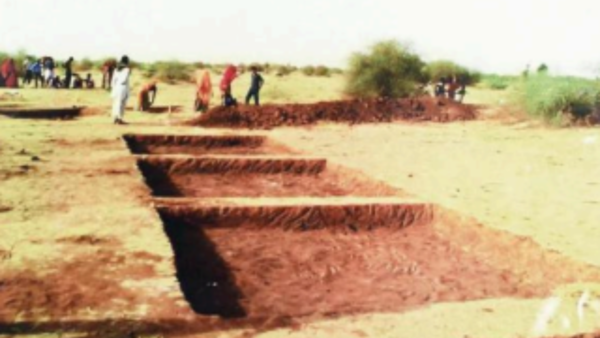Since the summer of 1969, he cut soil with a shovel to script water history in Rajasthan village | Jaipur News
Farmers here harvest Rabi crops and raise livestock, and the presence of khejri, neem, peepal and sheesham trees in the village may mislead people into thinking this is a fertile area with good moisture in the soil.

A file photo of chaukas near the village
This village of 300 households is different from most others in the region in the availability of water, which is a matter of pride for the residents. Drought still visits this region of erratic monsoon every alternate year or once in three years but hits the residents of Lapodiya and nearby villages less hard.
They give all credit to Thakur Laxman Singh, who transformed his ancestral village and some others nearby in the last four decades. Villagers were overjoyed when 67-year-old Singh was conferred with Padma Shri award last week for his pioneering work in water conservation.
Singh’s ‘Shramdan’ (volunteer work) campaign and innovative contour-based ‘chauka’ system have helped conserve water for irrigation of nearly 6,000 bighas in the region.
Coming from the small erstwhile ruling family of Lapodiya, Singh divides his life into two phases: the first starting at 15 in 1969 (Shramdan) and the second at 35 in 1990 (Chauka). He vividly remembers the summer of 1969 when the village had come to the verge of a famine due to water scarcity and he had to pick up a shovel and an axe along with fellow villagers to begin work that eventually led to a radical shift in the residents’ fortunes.
“In 1969, all wells and the only pond in the village dried up due to scanty rainfall. If the pond, filled with filth and never holding more than 10% of its capacity, was not repaired before monsoon, the entire village would slip into poverty and migration, and livestock would die. I asked my father to call a meeting of the villagers and proposed we do sharmdan to repair the pond and the wells. They refused, calling it a waste of time and money, but I knew they did not want to trust a teenager,” said Singh, sitting in his garh (fort) built by his great-great-grandfather around 1740 AD.
A 15-year-old Singh became the first to first to wield a shovel and an axe along with three of his friends to work at the pond. He then used his social position to mobilise villagers for the work. “The pond was ready in time and got filled with rainwater. We could avert a disaster. That was the turning point in my life,” said Singh.
For the next 21 years, Singh replicated the shramdan technique as a movement to repair waterbodies and build new ones in 40 villages. It helped residents carry out agriculture, dairy work, and fodder production successfully up to a self-sustenance level. But it left little for commercial exploitation and a hope for prosperity, and the recurring drought made their struggles harder.
This made Singh rethink the strategy in 1982. “I studied the rainfall pattern and collected samples from all 40 villages from 1982 till 1988. I took the help of environmentalists and geographers to map the flow of water, the land survey, and the course of rivers to finally devise a chauka system in 1990,” said Singh, flipping through an album of photos from the 1990s.
The chauka system comprises building a network of rectangular bunds of low height on the ground. The bunds hold water only up to 9 inches deep, and when one is filled with water up to 9 inches, the water overflows into another and so on. “An ideal chauka can be 100 feet by 70 feet and built on grazing grounds and individual farmlands. The process not only improves the groundwater table but also brings much-needed moisture in the soil,” said Singh.
This system, which was different from the government’s model, proved more efficient during the four-year-long drought starting in 1998. “Then chief secretary Inderjeet Khanna, who conducted a survey, wanted to take this model to all water-scarce parts of Rajasthan, but his tenure ended before he could do it. He advised me to start teaching the method, which I am still doing,” said Singh, who has had visitors from across India and abroad to study the chauka system.
“My village produces 10,000 litres of milk a day, which generates an income of Rs 40 lakh. Moong is the cash crop here with one bigha producing 400-500 kgs. Almost 70 households earn Rs 5 lakh on an average from moong. Then there are chana and mustard, which are grown the highest here,” said Singh, who has been working mainly in 40 villages-21 in Dudu tehsil of Jaipur district and 19 in Malpura tehsil of Tonk district.




